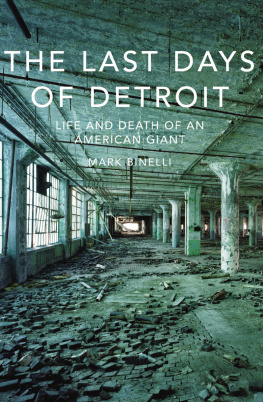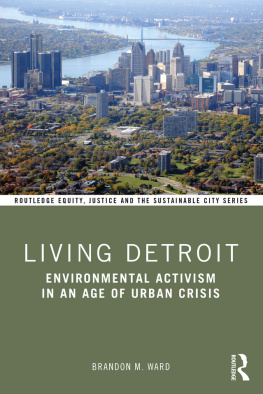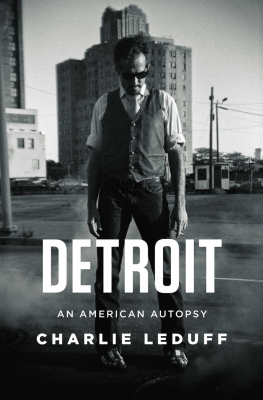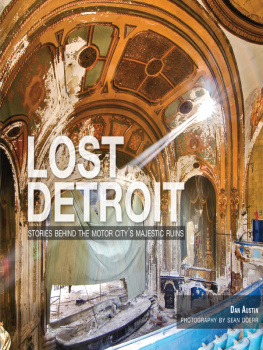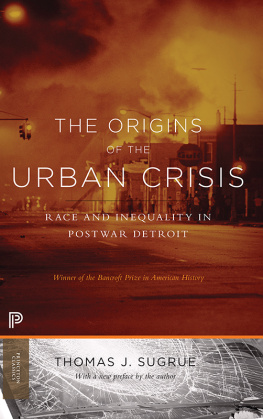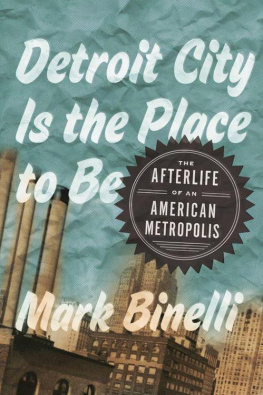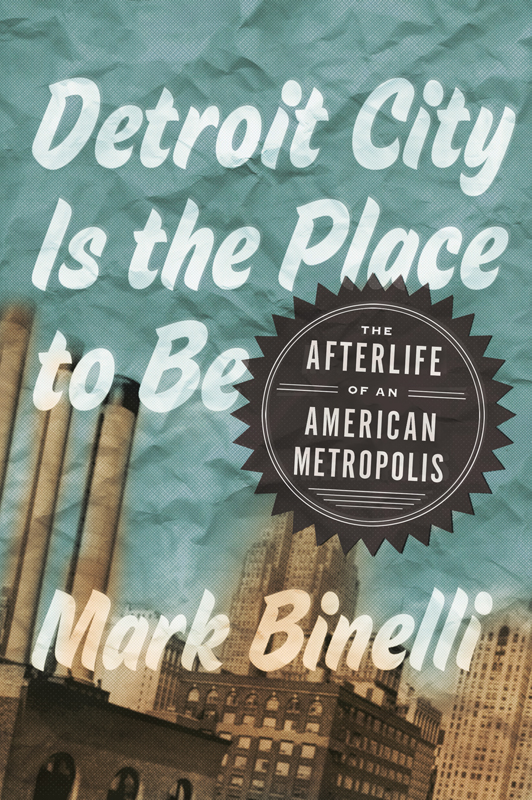
The author and publisher have provided this e-book to you for your personal use only. You may not make this e-book publicly available in any way. Copyright infringement is against the law. If you believe the copy of this e-book you are reading infringes on the authors copyright, please notify the publisher at: us.macmillanusa.com/piracy.
For Lydia and Evan, with much love
And Marco answered: While, at a sign from you, sire, the unique and final city raises its stainless walls, I am collecting the ashes of the other possible cities that vanish to make room for it, cities that can never be rebuilt or remembered. When you know at last the residue of unhappiness for which no precious stone can compensate, you will be able to calculate the exact number of carats toward which that final diamond must strive. Otherwise, your calculations will be mistaken from the very start.
Italo Calvino, Invisible Cities
CONTENTS
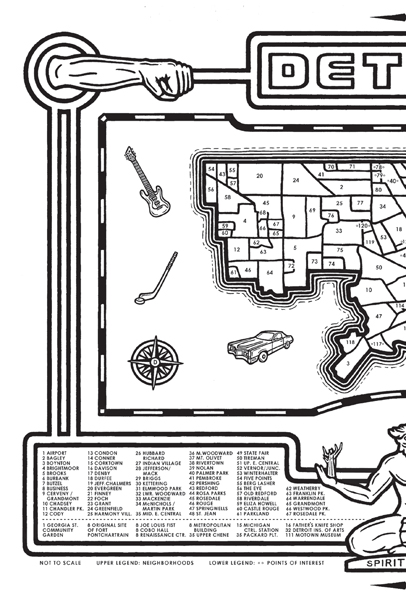
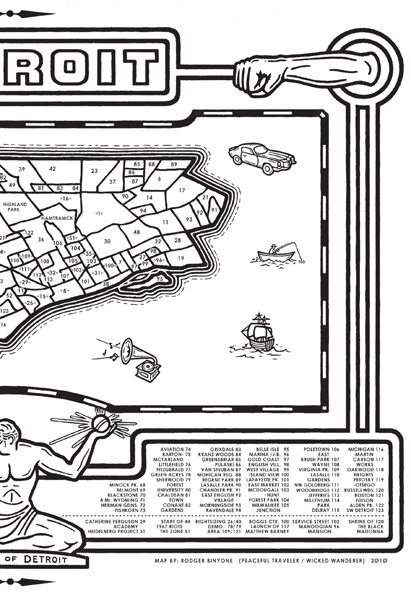
INTRODUCTION
B ACK WHEN I WAS a boy, growing up just outside of Detroit, my friends and I beheld any mention of the city in popular culture with a special thrill. We loved how Detroit was deemed terrifying enough to be chosen as the dystopian locale of RoboCop , the science fiction film set in a coyly undated near future, when Detroit had become so dangerous that the outsourcing of law enforcement to an armored, heavily weaponized cyborg would seem a prudent and necessary move. And when the producers of Beverly Hills Cop decided to make the hometown of Eddie Murphys fish-out-of-water detective our ownbecause, after all, what could be more antipodal to Rodeo Drive than Woodward Avenue, what more alien presence to the Beverly Palms Hotel than a black dude from Detroit in a Mumford High T-shirt?we delighted in that, too. We certainly tested the speakers of our American-made Dodge hatchbacks whenever a Detroit song found itself played on one of the competing local rock stations. Who would be churlish enough to flag these songs as relics of an earlier era or point out how the lyrics pivoted off the citys reputation for chaos, riotousness, destruction to such a degree the very titles Panic in Detroit (Bowie, 1973), Detroit Breakdown (J. Geils Band, 1974), Motor City Madhouse (Nugent, 1975)could be mistaken for headlines from July 1967? To this day, when the plangent opening piano chords of Journeys Dont Stop Believin blare from a dive bar jukebox, who among us begrudges even this most overplayed of power ballads a respectful split-second cock of the head and perhaps a secret inner smile as well, all because the protagonist of the song was born and raised in South Detroitno matter that there wasnt really a neighborhood called South Detroit or that the person living there wanted so badly to get the hell out he took a midnight train goin anywhere.
My parents subscribed to Time , and I can remember excitedly reading a story, at the height of the tension between Ronald Reagan and the Soviet Union, detailing the effects of a single nuclear bomb dropped on a major American city. This city, the editors explained, had been chosen entirely at randombut of course it was Detroit, a choice that by 1982 probably came across to most locals as an ungallant case of piling on. Still, at twelve years old, I devoured the shout-out as if the city had won some national lottery.
The article began, Say it is late April, a cloudless Thursday evening in Detroit. Assume further that there is no advance warning.
Beginning at ground zero of the blast and expanding concentrically, the story proceeded to describe, in gruesome detail, the fate of Detroit and its residents. If you happened to be watching a baseball game at the old Tiger Stadium, for example, you would immediately go blind. Then you would burst into flame. But, the writer continued, unhelpfully, the pain ends quickly: the explosions blast wave, like a super-hardened wall of air moving faster than sound, crushes the stands and the spectators into a heap of rubble.
Skyscrapers topple. Commuters melt inside their cars. Even Canadians in neighboring Windsorthis I found particularly satisfyingwould be fatally pelted with fragments of the Renaissance Center, hurled across the river by 160-m.p.h. winds. Following the geography of the article to my familys own suburb, I learned that, only a minute after the blast, fires would be already raging and tens of thousands of people dying, survivors crawl[ing] from wrecked homes to see an eight-mile-high mushroom cloud in the distance.
Butsurvivors! See , I pointed out to my little brother, even at that early age displaying the hopeful spirit that all Detroit-area natives learn by necessity to cultivate like a rare breed of flower. One of us might live!
* * *
Detroit used to be the greatest working-class city in the most prosperous country in the world. With the explosion of the auto industry, it had become the Silicon Valley of the Jazz Age, a capitalist dream town of unrivaled innovation and bountiful reward. My family came from Italy, our neighbor from Tennessee, my dads friends were from Poland, Lebanon, Mexico. All had been drawn to Detroit, if not explicitly for the auto industrymy father sharpened knives and sold restaurant equipmentthen because of what the auto industry had come to represent. The cars rolling off the assembly lines existed as tangible manifestations of the American Dream, the factories themselves a glimpse of the birth of modernity, in which mass production would beget mass employment and, in turn, mass consumption. Workers, eager to claim their share of the unprecedentedly high wages on offer, migrated to the city in droves, doubling Detroits population in a single decade, from 465,000 to nearly a million, making the city, by 1920, the fourth largest in the nation. The art deco skyscrapers bursting from the downtown streets like rockets must have seemed like monuments to Fordisms manifest destiny. Everything pointed up.
Often, people incorrectly isolate the 1967 riot as the pivotal Detroit-gone-wrong moment, after which nothing ever went right. In fact, the auto industry had been in a serious economic slump for at least a decade prior, with tension in the black community festering for even longer and the axial shift of jobs and white residents from city proper to suburbs solidly under way. What the civic unrest, aside from hastening the process, did permanently change was the national story line about the city. If, once, Detroit had stood for the purest fulfillment of U.S. industry, it now represented Americas most epic urban failure, the apotheosis of the new inner-city mayhem sweeping the nation like LSD and unflattering muttonchop sideburns. The fires of the rebellion launched a long-running narrative, one that persists today, of Detroit as a hopelessly failed state, a terrifying place of violent crime and general lawlessness. As John Lee Hooker, who had come north to work on the assembly line at Ford and later made his name as a bluesman in the juke joints of Detroits Hastings Street, sang in Motor City Is Burning:
My hometown burnin down to the ground
Worser than Vietnam
That, for as long as I can remember, might as well have been the unofficial slogan of the city. WELCOME TO DETROIT: WORSER THAN VIETNAM.


